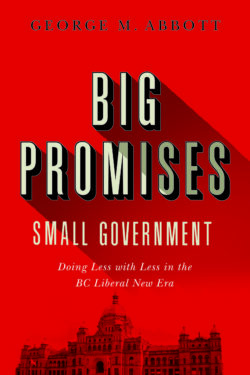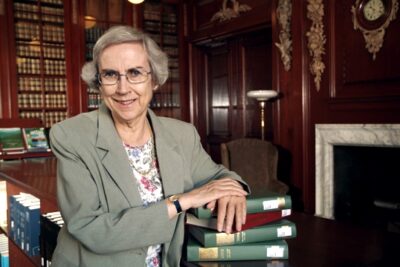1044 Campbell’s shortsighted edicts
Big Promises, Small Government: Doing Less with Less in the BC Liberal New Era
by George M. Abbott
Vancouver: UBC Press, 2020
$32.95 / 9780774864879
Reviewed by Patricia E. Roy
*
 Would Gordon Campbell like this book? He can answer for himself, but his response might well be, “Yes” and “No.” “Yes,” because as a “voracious reader” and “policy wonk,” he would appreciate the many references to studies of public policy which complement rather than obscure its essential arguments. Campbell, however, would not enjoy the severe criticisms of his first administration, 2001-2005.
Would Gordon Campbell like this book? He can answer for himself, but his response might well be, “Yes” and “No.” “Yes,” because as a “voracious reader” and “policy wonk,” he would appreciate the many references to studies of public policy which complement rather than obscure its essential arguments. Campbell, however, would not enjoy the severe criticisms of his first administration, 2001-2005.
George Abbott is an exceptionally well-qualified author. After teaching political science at Okanagan College, he was elected to the Legislature in the Liberal landslide of 2001 and joined the cabinet as Minister of Community, Aboriginal and Women’s Services. Between then and 2012, when he retired from politics, Abbott served in several other portfolios. After leaving the government, he completed a Ph.D. in Political Science at the University of Victoria with a dissertation, “Prescription before Diagnosis.” The titles of the dissertation and of this, the subsequent book, capture the interrelated major themes of Big Promises, Small Government: Doing Less with Less in the BC Liberal New Era.

The “New Era” platform, the election campaign slogan, promised bold and decisive actions “to open up government, to rebuild our economy and to lead the way to a New Era full of promise and potential for you and your family” (p. 5) Among the “Big Promises” in this thirty page document was a tax cut of an unspecified amount. On the second day of his premiership, Campbell reduced personal income taxes by 25 percent. Some weeks later, his government lowered corporate and some other taxes. Campbell expected these measures to promote economic growth and therefore government revenue. Instead of analyzing the local implications, the premier drew from an Ontario precedent. Unfortunately, British Columbia in 2001 was experiencing negligible growth whereas Ontario was already enjoying strong growth when it cut taxes. Abbott complains that in this, and in other cases, Campbell introduced policies without giving the public service sufficient time to assess their likely effects, in short, issuing a prescription without a diagnosis.
Reducing taxes did not stimulate the economy; revenues fell. Instead of fulfilling the many campaign promises, retrenchment was the order of the day. Only the ministries of Health, Education, and Advanced Education were exempt. Collectively, they were responsible for 70 percent of the government’s expenditures. Ironically, despite the New Era promise of “potential” for families, two social ministries, Human Resources and Children and Family Development, suffered such severe cuts that they had to ration or deny support for “vulnerable children and families” (p. 183). Abbott presents some of the resulting sad stories. The 2004 Budget increased funding for those ministries but a pending election, not rising revenues, was the cause.

While Abbott cites the problems of many ministries, his own ministry offers many examples to support his thesis. He had thirty-one “general responsibilities” as well as oversight of thirty-three boards, agencies, and commissions. In addition to programmes specifically concerning aboriginal and women’s services, the ministry dealt with such services as housing and a miscellany of matters relating to arts and culture including heritage sites and amateur sport. Opposition leader Joy MacPhail’s referred to it as “the ministry of lost causes” which Abbott indicates was not its “least appropriate sobriquet;” another nickname, “the incredible shrinking ministry” was more descriptive of what happened to it.
Just short of two months after taking office, the government released an economic and fiscal update which cut the budgets of most ministries. Abbott’s ministry had $13 million removed from its budget of which $6 million was for social housing, although the premier’s mandate letter to Abbott called for a programme to expand the supply of “affordable housing” (p. 126) There were other anomalies. While one mandate for the ministry was to “protect and promote Indigenous languages,” it was required to dissolve the First Peoples’ Heritage, Language and Culture Council (p. 132). Cuts to the budget continued; reduced programs and services and layoffs followed. By the end of the process, the ministry had lost 30 percent of its budget and 55 percent of its staff had either been laid off or transferred to other ministries.

All ministries faced a Core Review by a committee chaired by the premier. They had to demonstrate that their programmes served the public interest, were the most effective means of delivering the service, and were affordable within the “current fiscal environment” (p. 97) The goal was “to reduce the size and scope of government” (p. 94). Abbott suggests that Core Review was not a “thoughtful and considered assessment” of programs, but “a blunt and time-limited weapon to make government smaller” and to balance the budget (p. 188). If ministries did not eliminate sufficient programmes, Campbell had an External Panel review them.
Many policies of the Campbell government were borrowed from elsewhere, chiefly Alberta, Ontario, and New Zealand. Collectively these ideas were known as New Public Management. Although Abbott only heard the term while doing his doctoral studies, many of its principles such as lower taxes, balanced budgets, and smaller government, were not new in British Columbia.
Readers who expect a gossipy “tell all” exposé will be disappointed. Abbott honours his oath to preserve cabinet secrecy, but leaks meant that much reached the press. To supplement that and his own knowledge (he kept a journal), Abbott scoured secondary sources and government documents and interviewed, on the condition of anonymity, senior public servants. Abbott praises civil servants who displayed “courage and professionalism in the face of remarkably intimidating challenges” (p. 11).
As for the premier, Abbott offers a few vignettes to illustrate his “drive for power and control,” (p. 12) and his desire “to keep a tight leash on people and processes” (p. 95) In cabinet, Campbell had little patience with long discussions of topics on which he had already made up his mind. Abbott found Campbell was complex, “a political hybrid: when his instincts or the fiscal situation suggested retrenchment, he was a small-government conservative, but he was a social progressive on issues such as abortion, same-sex marriage, and safe-injection sites” (p. 47). To be fair, Abbott gives Campbell credit for changing his mind after listening and learning from others. Abbott, however, provides little detail of such changes, such as those on climate change, which mainly occurred after 2005. He does, however, list one success story of the first administration, the re-organization of the Ministry of Health Planning, which had a well-defined goal replacing fifty-two local health authorities with five regional bodies and had the financial resources to do so.

Big Promises is a well-informed examination of how policy was made in the first term of Gordon Campbell’s government. It offers the useful lesson that successful policies elsewhere should not be adopted in haste as they may not be timely or appropriate for British Columbia’s circumstances. Unfortunately, Abbott ends his study in 2005 although he remained in Campbell’s cabinet until 2012. His concluding remarks note that during the economic revival between 2005 and 2008, Campbell initiated some reforms especially in social and environmental matters. Let us hope that there will be a sequel. Gordon Campbell might even like it!
*

Patricia E. Roy, a native of British Columbia, is professor emeritus of History at the University of Victoria where she taught Canadian history for many years. Her own research has been mainly in the field of British Columbia history and she is best known for her trilogy of books on the responses to Chinese and Japanese immigrants: A White Man’s Province (1989); The Oriental Question (2003), and The Triumph of Citizenship (2007). All were published by UBC Press. Her longstanding interest in B.C.’s political history resulted in Boundless Optimism: Richard McBride’s British Columbia (UBC Press, 2012). Her latest book is The Collectors: A History of the Royal British Columbia Museum and Archives (Royal British Columbia Museum, 2018). Editor’s note: Patricia Roy has most recently reviewed books by Jesse Donaldson, Linda Kawamoto Reid, John Endo Greenaway, & Fumiko Greenaway, Kotaro Hayashi, Fumio “Frank” Kanno, Henry Tanaka, and Jim Tanaka, Ian Ferguson, Kunio Yamagishi, and Jesse Nishihata for The Ormsby Review.
*
The Ormsby Review. More Books. More Reviews. More Often.
Publisher and Editor: Richard Mackie
The Ormsby Review is a journal service for serious coverage of B.C. books and authors, hosted by Simon Fraser University. The Advisory Board consists of Jean Barman, Robin Fisher, Cole Harris, Wade Davis, Hugh Johnston, Patricia Roy, David Stouck, Maria Tippett, and Graeme Wynn. Scholarly Patron: SFU Graduate Liberal Studies. Honorary Patron: Yosef Wosk. Provincial Government Patron since September 2018: Creative BC
“Only connect.” – E.M. Forster
2 comments on “1044 Campbell’s shortsighted edicts”